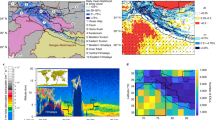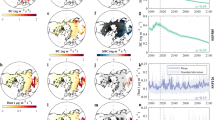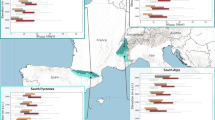Abstract
As one of the brightest natural surfaces on Earth, the darkening of snow by light-absorbing particles (LAPs) — dust, black carbon or microbial growth — can trigger albedo feedbacks and accelerate snowmelt. Indeed, an increase in black carbon deposition following the industrial revolution has led to the recognition that LAP radiative forcing has contributed to a reduction in the global cryosphere, with corresponding climatic impacts. This Review synthesizes our current understanding of the distribution of radiative forcing by LAPs in snow, and discusses the challenges that need to be overcome to constrain global impacts, including the limited scope of local-scale observations, limitations of remote sensing technology and the representation of LAP-related processes in Earth system models.
This is a preview of subscription content, access via your institution
Access options
Access Nature and 54 other Nature Portfolio journals
Get Nature+, our best-value online-access subscription
$29.99 / 30 days
cancel any time
Subscribe to this journal
Receive 12 print issues and online access
$209.00 per year
only $17.42 per issue
Buy this article
- Purchase on Springer Link
- Instant access to full article PDF
Prices may be subject to local taxes which are calculated during checkout




Similar content being viewed by others
References
Lemke, P. et al. in Climate Change 2007: The Physical Science Basis (eds Solomon, S. et al.) Ch. 4 (IPCC, Cambridge Univ. Press, 2007).
Sturm, M., Goldstein, M. A. & Parr, C. Water and life from snow: a trillion dollar science question. Water Resour. Res. 53, 3534–3544 (2017).
Landsberg, H. E. Man-made climatic changes: man’s activities have altered the climate of urbanized areas and may affect global climate in the future. Science 170, 1265–1274 (1970).
Doherty, S. J. et al. Observed vertical redistribution of black carbon and other insoluble light-absorbing particles in melting snow. J. Geophys. Res. Atmos. 118, 5553–5569 (2013).
Skiles, S. M. & Painter, T. H. Daily evolution in dust and black carbon content, snow grain size, and snow albedo during snowmelt, Rocky Mountains, Colorado. J. Glaciol. 63, 118–132 (2017).
Hall, A. & Qu, X. Using the current seasonal cycle to constrain snow albedo feedback in future climate change. Geophys. Res. Lett. 33, L03502 (2006).
Bond, T. C., Doherty, S. J., Fahey, D. W. & Forster, P. Bounding the role of black carbon in the climate system: a scientific assessment. J. Geophys. Res. Atmos. 118, 5380–5552 (2013).
McConnell, J. R. et al. 20th-century industrial black carbon emissions altered Arctic climate forcing. Science 317, 1381–1384 (2007).
Doherty, S., Warren, S., Grenfell, T., Clarke, A. & Brandt, R. Light-absorbing impurities in Arctic snow. Atmos. Chem. Phys. 10, 11647–11680 (2010).
Ming, J. et al. Black carbon (BC) in the snow of glaciers in west China and its potential effects on albedos. Atmos. Res. 92, 114–123 (2009).
Hegg, D. A. et al. Source attribution of black carbon in Arctic snow. Environ. Sci. Technol. 2009, 4016–4021 (2009).
Keegan, K. M., Albert, M. R., McConnell, J. R. & Baker, I. Climate change and forest fires synergistically drive widespread melt events of the Greenland Ice Sheet. Proc. Natl Acad. Sci. USA 111, 7964–7967 (2014).
Kaspari, S., Skiles, S. M., Delaney, I., Dixon, D. & Painter, T. H. Accelerated glacier melt on snow dome, Mt. Olympus, Washington, USA due to deposition of black carbon and mineral dust from wildfire. J. Geophys. Res. Atmos. 120, 2793–2807 (2015).
Andreae, M. O. in World Survey of Climatology Vol. 16 (ed. Henderson-Sellers, A.) Ch. 10 (Elsevier Science, Amsterdam, 1995).
Tegen, I. & Schepanski, K. Climate feedback on aerosol emission and atmospheric concentrations. Curr. Clim. Change Rep. 4, 1–10 (2018).
Mahowald, N. M. et al. Observed 20th century desert dust variability: impact on climate and biogeochemistry. Atmos. Chem. Phys. 10, 10875–10893 (2010).
Franzén, L. G., Mattsson, J. O., Mårtensson, U., Nihlén, T. & Rapp, A. Yellow snow over the Alps and Subarctic from dust storm in Africa, March 1991. Ambio 23, 233–235 (1994).
Painter, T. H. et al. Impact of disturbed desert soils on duration of mountain snow cover. Geophys. Res. Lett. 34, L12502 (2007).
Thompson, L. G. et al. A high-resolution millennial record of the south Asian monsoon from Himalayan ice cores. Science 289, 1916–1919 (2000).
Di Mauro, B. et al. Mineral dust impact on snow radiative properties in the European Alps combining ground, UAV, and satellite observations. J. Geophys. Res. Atmos. 120, 6080–6097 (2015).
Skiles, S. M., Painter, T. H. & Okin, G. S. A method to retrieve the spectral complex refractive index and single scattering optical properties of dust deposited in mountain snow. J. Glaciol. 63, 133–147 (2017).
Skiles, S. M. & Painter, T. H. Assessment of radiative forcing by light absorbing particles in snow from in situ observations with radiative transfer modeling. J. Hydrometeorol. https://doi.org/10.1175/JHM-D-18-0072.1 (2018).
Sterle, K. M., McConnell, J. R., Dozier, J., Edwards, R. & Flanner, M. Retention and radiative forcing of black carbon in the Eastern Sierra Nevada snow. Cryosphere 7, 365–374 (2013).
Kaspari, S., Painter, T. H., Gysel, M., Skiles, S. M. & Schwikowski, M. Seasonal and elevational variations of black carbon and dust in snow and ice in the Solu-Khombu, Nepal and estimated radiative forcings. Atmos. Chem. Phys. 14, 8089–8103 (2014).
Hoham, R. W. & Duval, B. in Snow Ecology: An Interdisciplinary Examination of Snow-Covered Ecosystems (ed. Jones, H. G.) 166–226 (Cambridge Univ. Press, Cambridge, 2001).
Williamson, C. et al. Ice algal bloom development on the surface of the Greenland Ice Sheet. FEMS Microbiol. Ecol. 94, fiy025 (2018).
Dial, R. J., Ganey, G. Q. & Skiles, S. M. What color should glacier algae be?. FEMS Microbiol. Ecol. 53, fiy007 (2018).
Thomas, W. H. & Duval, B. Sierra Nevada, California, U. S. A., snow algae: snow albedo changes, algal-bacterial interrelationships, and ultraviolet radiation effects. Arctic Alpine Res. 27, 389–399 (1995).
Painter, T. H. et al. Detection and quantification of snow algae with an airborne imaging spectrometer. Appl. Environ. Microbiol. 67, 5267–5272 (2001).
Ganey, G. Q., Loso, M. G., Burgess, A. B. & Dial, R. J. The role of microbes in snowmelt and radiative forcing on an Alaskan icefield. Nat. Geosci. 10, 754–759 (2017).
Qian, Y. et al. Light-absorbing particles in snow and ice: measurement and modeling of climatic and hydrologic impact. Adv. Atmos. Sci. 32, 64–91 (2015).
Ramanathan, V. & Carmichael, G. Global and regional climate changes due to black carbon. Nat. Geosci. 1, 221–227 (2008).
Gertler, C. G., Puppala, S. P., Panday, A., Stumm, D. & Shea, J. Black carbon and the Himalayan cryosphere: a review. Atmos. Environ. 125, 404–417 (2016).
Qian, Y., Flanner, M. G., Leung, L. R. & Wang, W. Sensitivity studies on the impacts of Tibetan Plateau snowpack pollution on the Asian hydrological cycle and monsoon climate. Atmos. Chem. Phys. 11, 1929–1948 (2011).
Kaspari, S. et al. Recent increase in black carbon concentrations from a Mt. Everest ice core spanning 1860–2000 AD. Geophys. Res. Lett. 38, L04703 (2011).
Ming, J. et al. Black carbon record based on a shallow Himalayan ice core and its climatic implications. Atmos. Chem. Phys. 8, 1343–1352 (2008).
Wang, M. et al. Carbonaceous aerosols recorded in a southeastern Tibetan glacier: analysis of temporal variations and model estimates of sources and radiative forcing. Atmos. Chem. Phys. 15, 1191–1204 (2015).
Zhang, R. et al. Quantifying sources, transport, deposition, and radiative forcing of black carbon over the Himalayas and Tibetan Plateau. Atmos. Chem. Phys. 15, 6205–6223 (2015).
Ginot, P. et al. A 10 year record of black carbon and dust from a Mera Peak ice core (Nepal): variability and potential impact on melting of Himalayan glaciers. Cryosphere 8, 1479–1496 (2014).
Painter, T. H., Bryant, A. & Skiles, S. M. Radiative forcing by light absorbing impurities in snow from MODIS surface reflectance data. Geophys. Res. Lett. 39, L17502 (2012).
Matt, F. & Burkhart, J. Assessing satellite derived radiative forcing from snow impurities through inverse hydrologic modelling. Geophys. Res. Lett. 45, 3531–3541 (2018).
Flanner, M. G., Zender, C. S., Randerson, J. T. & Rasch, P. J. Present-day climate forcing and response from black carbon in snow. J. Geophys. Res. 112, D11202 (2007).
Flanner, M. G. et al. Springtime warming and reduced snow cover from carbonaceous particles. Atmos. Chem. Phys. 9, 2481–2497 (2009).
Wang, X., Doherty, S. J. & Huang, J. Black carbon and other light‐absorbing impurities in snow across Northern China. J. Geophys. Res. Atmos. 118, 1471–1492 (2013).
Qian, Y., Wang, H., Zhang, R., Flanner, M. G. & Rasch, P. J. A sensitivity study on modeling black carbon in snow and its radiative forcing over the Arctic and Northern China. Environ. Res. Lett. 9, 064001 (2014).
Dang, C. et al. Measurements of light‐absorbing particles in snow across the Arctic, North America, and China: effects on surface albedo. J. Geophys. Res. Atmos. 122, 10149–10168 (2017).
Zhao, C. et al. Simulating black carbon and dust and their radiative forcing in seasonal snow: a case study over North China with field campaign measurements. Atmos. Chem. Phys. 14, 11475–11491 (2014).
De Angelisi, M. & Gaudichet, A. Saharan dust deposition over Mont Blanc (French Alps) during the last 30 years. Tellus B 43, 61–75 (1991).
Di Mauro, B. et al. Impact of impurities and cryoconite on the optical properties of the Morteratsch Glacier (Swiss Alps). Cryosphere 11, 2393–2409 (2017).
Gabbi, J., Huss, M., Bauder, A., Cao, F. & Schwikowski, M. The impact of Saharan dust and black carbon on albedo and long-term mass balance of an Alpine glacier. Cryosphere 9, 1385–1400 (2015).
Painter, T. H. et al. End of the Little Ice Age in the Alps forced by industrial black carbon. Proc. Natl Acad. Sci. USA 110, 15216–15221 (2013).
Oerlemans, J., Giesen, R. & Van den Broeke, M. Retreating alpine glaciers: increased melt rates due to accumulation of dust (Vadret da Morteratsch, Switzerland). J. Glaciol. 55, 729–736 (2009).
Wittmann, M. et al. Impact of dust deposition on the albedo of Vatnajökull ice cap, Iceland. Cryosphere 11, 741–754 (2017).
Flanner, M., Gardner, A., Eckhardt, S., Stohl, A. & Perket, J. Aerosol radiative forcing from the 2010 Eyjafjallajökull volcanic eruptions. J. Geophys. Res. Atmos. 119, 9481–9491 (2014).
Björnsson, H. et al. Contribution of Icelandic ice caps to sea level rise: Trends and variability since the Little Ice Age. Geophys. Res. Lett. 40, 1546–1550 (2013).
Tuzet, F. et al. A multilayer physically based snowpack model simulating direct and indirect radiative impacts of light-absorbing impurities in snow. Cryosphere 11, 2633–2653 (2017).
Di Mauro, B. et al. On the role of Saharan dust events on snow season duration in the European Alps. In 20th EGU General Assembly 12169 (EGU, 2018).
Matt, F. N., Burkhart, J. F. & Pietikäinen, J.-P. Modelling hydrologic impacts of light absorbing aerosol deposition on snow at the catchment scale. Hydrol. Earth Syst. Sci. 22, 179–201 (2018).
Ginoux, P. et al. Analysis of aerosol deposition on snowpack over global high mountain ranges. In 20th EGU General Assembly 10062 (EGU, 2018).
Qian, Y., Gustafson, W. I., Leung, L. R. & Ghan, S. J. Effects of soot-induced snow albedo change on snowpack and hydrological cycle in western United States based on Weather Research and Forecasting chemistry and regional climate simulations. J. Geophys. Res. 114, D03108 (2009).
Oaida, C. M. et al. Improving snow albedo processes in WRF/SSiB regional climate model to assess impact of dust and black carbon in snow on surface energy balance and hydrology over western US. J. Geophys. Res. Atmos. 120, 3228–3248 (2015).
Hadley, O., Corrigan, C., Kirchstetter, T., Cliff, S. & Ramanathan, V. Measured black carbon deposition on the Sierra Nevada snow pack and implication for snow pack retreat. Atmos. Chem. Phys. 10, 7505–7513 (2010).
Wu, C., Liu, X., Lin, Z., Rahimi-Esfarjani, S. R. & Lu, Z. Impacts of absorbing aerosol deposition on snowpack and hydrologic cycle in the Rocky Mountain region based on variable-resolution CESM (VR-CESM) simulations. Atmos. Chem. Phys. 18, 511–533 (2018).
Seidel, F. C., Rittger, K., Skiles, S. M., Molotch, N. P. & Painter, T. H. Case study of spatial and temporal variability of snow cover, grain size, albedo and radiative forcing in the Sierra Nevada and Rocky Mountain snowpack derived from imaging spectroscopy. Cryosphere 10, 1229–1244 (2016).
Neff, J. C. et al. Increasing eolian dust deposition in the western United States linked to human activity. Nat. Geosci. 1, 189–195 (2008).
Skiles, S. M., Painter, T. H., Deems, J., Landry, C. & Bryant, A. Dust radiative forcing in snow of the Upper Colorado River Basin. Part II: interannual variability in radiative forcing and snowmelt rates. Water Resour. Res. 48, W07522 (2012).
Painter, T. H. et al. Response of Colorado River runoff to dust radiative forcing in snow. Proc. Natl Acad. Sci. USA 107, 17125–17130 (2010).
Bryant, A., Painter, T. H., Deems, J. & Bender, S. M. Hydrologic response to dust radiative forcing in snow in the Upper Colorado River Basin. Geophys. Res. Lett. 40, 3945–3949 (2013).
Minder, J. R., Letcher, T. W. & Skiles, S. M. An evaluation of high‐resolution regional climate model simulations of snow cover and albedo over the Rocky Mountains, with implications for the simulated snow‐albedo feedback. J. Geophys. Res. Atmos. 121, 9069–9088 (2016).
Clark, A. D. & Noone, K. J. Soot in the Arctic snowpack: a cause for perturbations in radiative transfer. Atmos. Environ. 19, 2045–2053 (1985).
Holland, M. M., Bailey, D. A., Briegleb, B. P., Light, B. & Hunke, E. Improved sea ice shortwave radiation physics in CCSM4: The impact of melt ponds and aerosols on Arctic sea ice. J. Clim. 25, 1413–1430 (2012).
Ryan, J. C. et al. Dark zone of the Greenland Ice Sheet controlled by distributed biologically-active impurities. Nat. Commun. 9, 1065 (2018).
Tedstone, A. J. et al. Dark ice dynamics of the south-west Greenland Ice Sheet. Cryosphere 11, 2491–2506 (2017).
Stibal, M. et al. Algae drive enhanced darkening of bare ice on the Greenland ice sheet. Geophys. Res. Lett. 44, 11463–11471 (2017).
Enderlin, E. M. et al. An improved mass budget for the Greenland ice sheet. Geophys. Res. Lett. 41, 866–872 (2014).
Hansen, J. & Nazarenko, L. Soot climate forcing via snow and ice albedos. Proc. Natl Acad. Sci. USA 101, 423–428 (2004).
Boucher, O. et al. in Climate Change 2013: The Physical Science Basis (eds Stocker, T. F. et al.) 571–657 (IPCC, Cambridge Univ. Press, 2013).
Myhre, G. et al. in Climate Change 2013: The Physical Science Basis (eds Stocker, T. F. et al.) Ch. 8 (IPCC, Cambridge Univ. Press, 2013).
Breider, T. J. et al. Multidecadal trends in aerosol radiative forcing over the Arctic: contribution of changes in anthropogenic aerosol to Arctic warming since 1980. J. Geophys. Res. Atmos. 122, 3573–3594 (2017).
Legrand, M. et al. Major 20th century changes of carbonaceous aerosol components (EC, WinOC, DOC, HULIS, carboxylic acids, and cellulose) derived from Alpine ice cores. J. Geophys. Res. Atmos. 112, D23S11 (2007).
Klingmüller, K., Pozzer, A., Metzger, S., Stenchikov, G. L. & Lelieveld, J. Aerosol optical depth trend over the Middle East. Atmos. Chem. Phys. 16, 5063–5073 (2016).
Hadley, O. L. & Kirchstetter, T. W. Black-carbon reduction of snow albedo. Nat. Clim. Change 2, 437–440 (2012).
Skiles, S. M. Dust and Black Carbon Radiative Forcing Controls on Snowmelt in the Colorado River Basin. PhD thesis, Univ. California-Los Angeles (2014).
Warren, S. G. Can black carbon in snow be detected by remote sensing? J. Geophys. Res. Atmos. 118, 779–786 (2013).
IPCC Climate Change 2013: The Physical Science Basis (eds Stocker, T. F. et al.) (Cambridge Univ. Press, 2013).
Acknowledgements
Part of this work was performed at the Jet Propulsion Laboratory, California Institute of Technology under contract with NASA. CNRM/CEN is part of Labex OSUG@2020 (ANR-10-LABX-56). Work by M.D. on LAP in snow is funded by an ANR JCJC EBONI grant (ANR-16-CE01-0006). J.M.C. acknowledges funding from the UK NERC grant ‘Black and Bloom’ (NE/M021025/1) and the Rolex Awards for Enterprise.
Author information
Authors and Affiliations
Contributions
S.M.M. drafted the initial manuscript, and incorporated content from M.F. on Earth system modelling, J.M.C. on microbial/biological radiative forcing, M.D. on radiative forcing by LAPs in snow in Europe and T.H.P. on remote sensing. All authors contributed to editing, revising and improving the Review.
Corresponding author
Ethics declarations
Competing interests
The authors declare no competing interests.
Additional information
Publisher’s note: Springer Nature remains neutral with regard to jurisdictional claims in published maps and institutional affiliations.
Rights and permissions
About this article
Cite this article
Skiles, S.M., Flanner, M., Cook, J.M. et al. Radiative forcing by light-absorbing particles in snow. Nature Clim Change 8, 964–971 (2018). https://doi.org/10.1038/s41558-018-0296-5
Received:
Accepted:
Published:
Issue Date:
DOI: https://doi.org/10.1038/s41558-018-0296-5
This article is cited by
-
Glacier retreat and lake outburst floods in the central Himalayan region from 2000 to 2022
Natural Hazards (2024)
-
Air Pollution Interactions with Weather and Climate Extremes: Current Knowledge, Gaps, and Future Directions
Current Pollution Reports (2024)
-
A review of physicochemical properties of dissolved organic carbon and its impact over mountain glaciers
Journal of Mountain Science (2024)
-
Climate-relevant properties of black carbon aerosols revealed by in situ measurements: a review
Progress in Earth and Planetary Science (2023)
-
Black carbon scavenging by low-level Arctic clouds
Nature Communications (2023)



